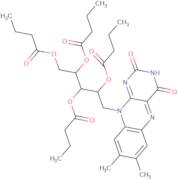Riboflavin Tetrabutyrate
CAS: 752-56-7
Ref. 3D-AAA75256
| 2g | Discontinued | ||
| 5g | Discontinued | ||
| 10g | Discontinued | ||
| 25g | Discontinued | ||
| 50g | Discontinued | ||
| 100g | Discontinued | ||
| 250g | Discontinued |
Product Information
- 2,3,4,5-tetra-O-butanoyl-1-deoxy-1-(7,8-dimethyl-2,4-dioxo-3,4-dihydrobenzo[g]pteridin-10(2H)-yl)-D-ribitol
- 2,3,4,5-tetra-O-butanoyl-1-deoxy-1-(7,8-dimethyl-2,4-dioxo-3,4-dihydrobenzo[g]pteridin-10(2H)-yl)pentitol
- Benzo[g]pteridine, riboflavin deriv.
- Bituvitan
- Eyekas
- Hibon
- Lacflavin
- Riboflavin tetrabutylate
- Riboflavin, 2′,3′,4′,5′-tetrabutanoate
- Riboflavin-2′,3′,4′,5′-tetrabutyrate
- See more synonyms
- Riboflavine tetrabutyrate
- Riboflavine, 2′,3′,4′,5′-tetrabutyrate
- Ribolact
- Tetra-O-butyrylriboflavin
- Viras
- Vitamin B<sub>2</sub> 2′,3′,4′,5′-tetrabutyrate
- Vitamin B<sub>2</sub> tetrabutyrate
- Wakaflavin L
- Riboflavin tetrabutyrate
Riboflavin Tetrabutyrate is a crystalline cellulose that has been chemically modified to allow it to dissolve in methanol. The chemical modification is achieved by the introduction of glycol esters into the molecular structure. This product is used as an antioxidant and as a skin cancer treatment. Riboflavin Tetrabutyrate has also been shown to have photochemical properties, which may be due to its ability to absorb ultraviolet light and release free radicals or oxygen. Riboflavin Tetrabutyrate has been shown to inhibit enzyme activities, such as reduction of NADP+, oxidation of NADPH, and hydroxylation of proline, all of which are important for cellular metabolism. Riboflavin Tetrabutyrate has a redox potential that ranges from -0.9 V to -1.4 V, depending on pH conditions and the presence of other substances such as water vapor.





